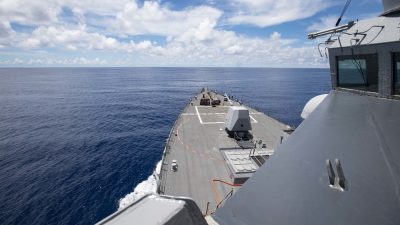Three NATO Aircraft Carrier Strike Groups, 13 U.S. Anti-missile Ships in the Mediterranean

All Global Research articles can be read in 51 languages by activating the “Translate Website” drop down menu on the top banner of our home page (Desktop version).
To receive Global Research’s Daily Newsletter (selected articles), click here.
Visit and follow us on Instagram at @globalresearch_crg.
***
On February 10 the U.S. Naval Institute website published a report that four more Arleigh Burke-class guided missile destroyers had been sent to the Mediterranean Sea. The deployment, in addition to four (and soon to be six) of the warships permanently rotated out of the Naval Station Rota in Spain, was described by a Navy spokesman as designed to allow them to “participate in a range of maritime activities in support of the U.S. 6th Fleet and our NATO allies.”
The four ships, USS Donald Cook, USS Gonzalez, USS Mitscher and USS The Sullivans, joined their counterparts USS Arleigh Burke, USS Porter, USS Roosevelt, USS Ross and the Harry S. Truman Carrier Strike Group operating in the Mediterranean Sea already.
The Harry S. Truman Carrier Strike Group, which has “been on station near the entrance to the Black Sea since late December under orders from Defense Secretary Lloyd Austin,” recently engaged in the Neptune Strike 22 joint exercise with the French carrier Charles de Gaulle and Italian carrier Cavour strike groups. Harry S. Truman can accommodate 90 fixed wing aircraft and helicopters. Sixth Fleet reports it currently hosts nine squadrons of the Carrier Air Wing One.
Arleigh Burke-class guided missile destroyers USS Bainbridge, USS Gonzalez, USS Gravely and USS Ross and Ticonderoga-class cruisers USS Cole, USS Jason Dunhamand USS San Jacinto participated in the drills. All of the above except for USS Rosswere assigned to the Harry S. Truman Carrier Strike Group; USS Ross was assigned to the Charles de Gaulle strike group. The three cruisers are assigned to the U.S. Fifth and not Sixth Fleet. The latter operates in the Mediterranean; the former in the Persian Gulf, Red Sea, Arabian Sea, and part of the Indian Ocean. They were deployed to the Mediterranean for the occasion.
In all that adds up to ten destroyers and three cruisers that are part of Lockheed Martin’s Aegis Combat System, which is an integral component of NATO’s missile defense system. It is the naval, and almost the entirety, of the Pentagon’s ballistic missile defense (BMD) system.
The U.S.’s 68 Arleigh Burke-class guided missile destroyers and 22 Ticonderoga-class cruisers, equipped to fire Tomahawk cruise missiles, also provide the delivery capabilities for the Navy’s Aegis Ballistic Missile Defense System as they can also launch Standard Missile 3 surface-to-air missiles to intercept ballistic missiles and satellites. An Arleigh Burke destroyer carries 56 Tomahawk missiles. A Ticonderoga cruiser accommodates 26. The entire fleet of Aegis warships, then, can fire 4,380 cruise missiles and an undetermined amount of Standard Missile 3 interceptors.
The above is a formidable armada, which is several times more lethal than all other nations’ capacities combined (the U.S. also has all the world’s eleven supercarriers and those eleven are the sole nuclear carriers except for France’s Charles de Gaulle), and the deployment of at least thirteen of its anti-ballistic warships in the Mediterranean-Black Sea region is a dangerous escalation of tensions in an already tense environment.
*
Note to readers: Please click the share buttons above or below. Follow us on Instagram, @globalresearch_crg. Forward this article to your email lists. Crosspost on your blog site, internet forums. etc.
Rick Rozoff, renowned author and geopolitical analyst, actively involved in opposing war, militarism and interventionism for over fifty years. He manages the Anti-Bellum and For peace, against war website.
He is a Research Associate of the Centre for Research on Globalization (CRG).
Featured image: The Arleigh Burke-class guided-missile destroyer USS Ralph Johnson (DDG 114) steams near the Spratly Islands in the South China Sea. July 14, 2020 © U.S. Navy Photo by Mass Communication Specialist 3rd Class Anthony Collier

